The Museo Storico Italiano della Guerra (Italian War History Museum), founded in 1921 and located in the Castle of Rovereto, tells the story of Italian conflicts between the 19th and 20th centuries. It offers in-depth examinations of the military, cultural and social aspects of the conflicts, especially in borderlands such as Trentino. Towers and embankments in the Castle of Venetian origin illustrate how defensive architecture has changed. At the same time, temporary exhibitions aim to preserve the memory of the conflicts of the last century.
Table of Contents
The Castle of Rovereto
The Castle of Rovereto, home to the Museo Storico Italiano della Guerra, is an important testimony to 15th-century military architecture, built at the end of the 13th century by the Castelbarco family to control the Adige Valley. Its solid walls and mighty bastions represent a unique example of a Venetian fortress in Trentino.
PLAN YOUR TRIP TO ITALY
Stay connected on the go with a Holafly eSIM, offering unlimited data at reliable 3G, 4G, and LTE speeds across Italy.
For added peace of mind during your travels, take out Heymondo travel insurance, perfect for a stress-free and well-protected adventure.
If you plan to explore beyond the main cities, renting a car is the best way to discover Italy’s hidden gems at your own pace.
The museum tour passes through the inner part of the defensive embankment and the Marino and Malipiero towers, which exhibit prehistoric, medieval, and modern weapons. The history of the Castle is also very fascinating. In 1487, during the war between Venice and the Archduke of Austria, Sigismund Count of Tyrol, the Castle sustained 37 days of siege and only surrendered after artillery severely damaged it. Once reconquered, the Venetians rebuilt the Castle with its current pentagonal shape, more resistant to enemy attacks.
Later, the Castle lost its strategic importance and was used for purposes other than defence, with functions ranging from shelter to prison. During the First World War, together with the city of Rovereto, it suffered intense bombardment by Italian artillery. It was finally restored in the 1920s to transform into a museum.
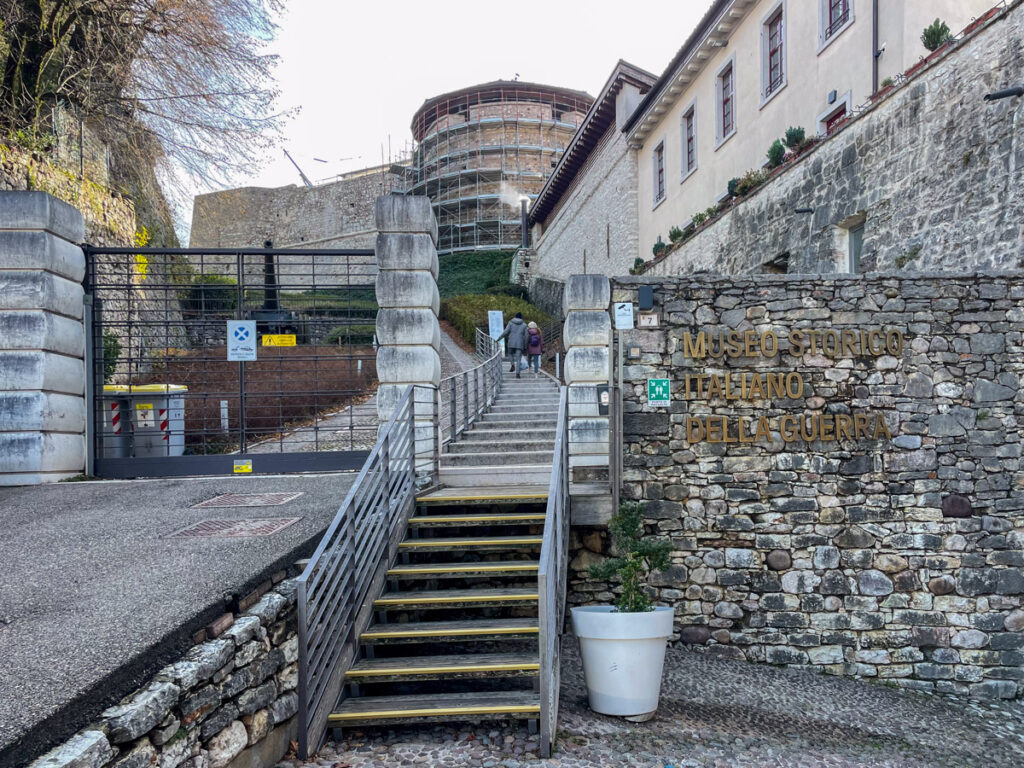
What to see at the Museo Storico Italiano della Guerra in Rovereto
Initially, the Museo Storico Italiano della Guerra was intended to document the impact of the First World War on the Rovereto area due to its proximity to the front and the deportation of the population to other regions of the Austro-Hungarian Empire. However, over time, it broadened its focus from the Napoleonic era to the Italian colonial wars.
Today, the museum’s collection includes weapons, uniforms, works of art, photographs, relics, posters, objects of everyday life in the trenches, honours, letters and diaries from different eras, collected thanks to public donations, local associations and private contributions. The exhibition thus offers an overview of war and its horrors, from the birth of modern armies to global war.
The exhibition route from the Napoleonic Wars to the First World War
The Italian Historical Museum of War and Rovereto Castle offers an insight into the radical transformation that took place in the way of fighting due to the evolution of military equipment and the formation of armies from the 19th to the 20th century.
The exhibit has two main parts, each focusing on different aspects. The first section explores military history from the end of the Napoleonic era to the First World War. The second section, on the other hand, traverses the Venetian embankment and towers with explanations of the architecture of the Castle and a display of weapons from the modern era. At the end of the tour, you can also see temporary exhibitions.
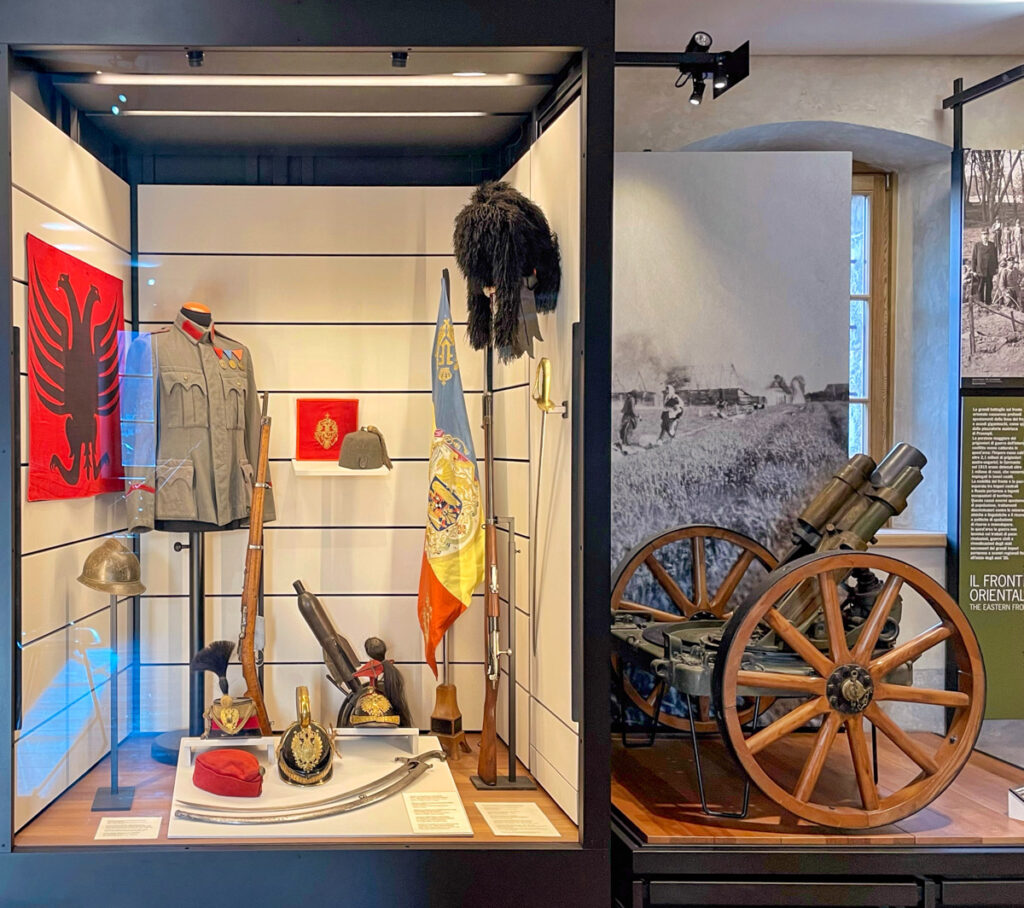
French Revolution and Risorgimento
Before the French Revolution, armies had just professional soldiers, and no compulsory military conscription existed. Nationalism and the creation of new States also led to a new way of experiencing wars, often as liberation and independence movements.
In the section on the Italian Risorgimento, you can see a collection of patriotic ceramics that decorated bourgeois drawing rooms. Their depiction of episodes and protagonists contributed to the process of building an Italian national identity. Indeed, the construction of national identities in the 19th century passed through the creation of heroes and symbols such as anthems and flags.
Wars of the early 20th century
The experimentation with new weapons, such as machine guns, aviation and torpedoes, characterised the conflicts of the early 20th century. Consequently, the uniforms of the armies also changed. They were no longer coloured to distinguish the parties on the battlefield. Still, they were neutral or camouflaged and adapted to the new way of fighting.
Technological innovations, the mobilisation of armies and war propaganda strongly impacted the civilian population. During the Italo-Turkish conflict, Italy was the first to practice aerial bombardment in Libya, shifting the war from battlefields to population centres.
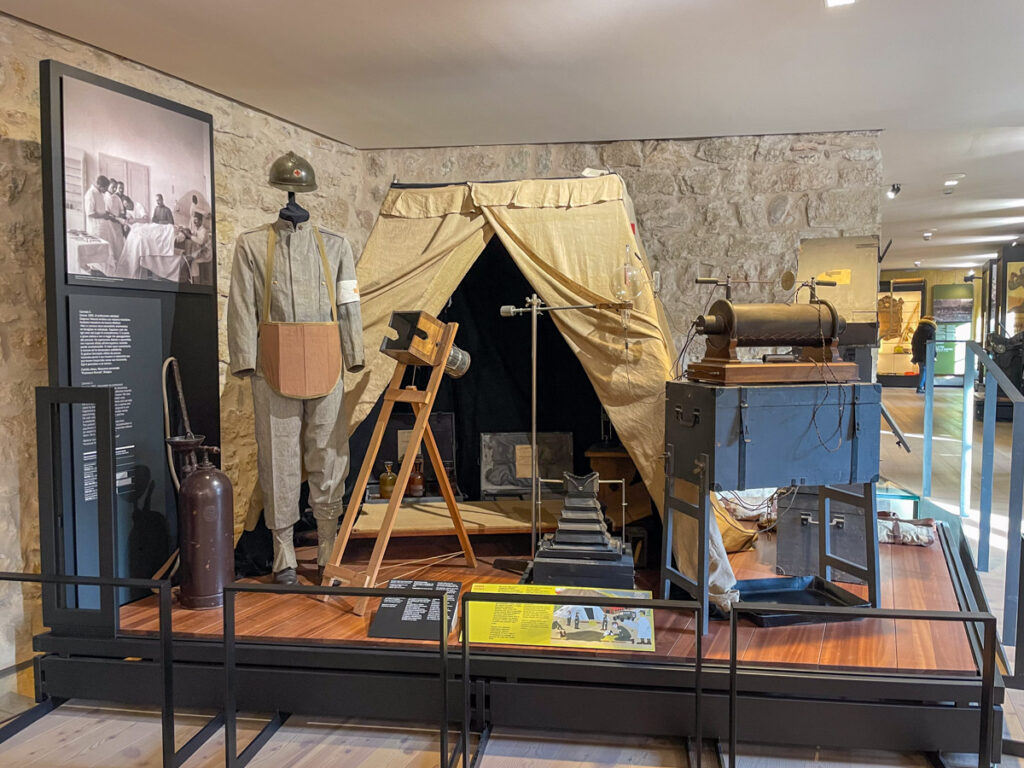
The First World War
The exhibition dedicated to the First World War features a recently restored Nieuport-Macchi Ni.10 biplane, one of the few surviving aircraft used during the Great War. The exhibition recounts the harshness of life on the front line, with soldiers busy building trenches, roads and shelters and transporting materials and equipment for much of the day.
The First World War was also a global conflict because, apart from Europe, it was fought in Africa, the Middle East and the Far East, blocking trade flows and the geography of mercantile exchanges. The submarine war initiated by Germany provoked the entry of the United States into the war. The colonies participated in the conflict by providing soldiers, workers and economic resources.
Another drama of the First World War was the internment of civilians of other nationalities to prevent them from enlisting in their country’s armies. Between 1914 and 1920, at least 800,000 civilians, 4,000 of whom were from Trentino, were interned in Europe. Trentino was a borderland between Italy and the Austro-Hungarian Empire, with the Trentino people of Italian language and culture on one side and the population of South Tyrol of German language and culture on the other.
A little-known aspect of the First World War that you can learn more about at the Italian War History Museum in Rovereto is the selective memory developed at the end of the conflict. The experiences of Trentino soldiers in Austro-Hungarian uniforms were forgotten. At the same time, monuments erected to the fallen Italians celebrate their heroism and justify the loss of life.
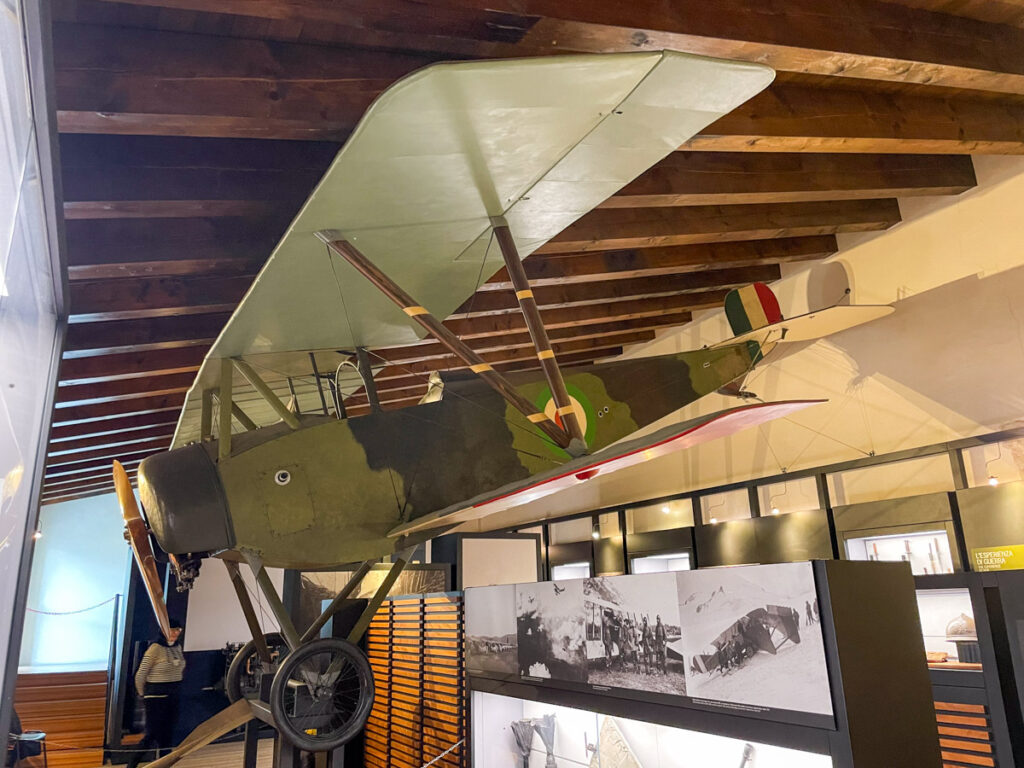
The Venetian fortifications of the Castle
The Italian War History Museum is within the restored spaces of the Venetian-era Rovereto Castle. The tour allows you to discover its evolution over the centuries and how the architecture responded to the increasing use of siege artillery by constructing the embankment and the two towers, Marino and Malipiero.
The towers display the museum’s oldest collections, including prehistoric weapons, armour and weapons from the Middle Ages to the modern age. The rampart, built in the late 15th and early 16th centuries, is a large mass of earth placed between two curtain walls to counteract the force of the artillery. In the exhibition spaces, videos and images tell the story of the 16th-century way of fighting with soldiers organised in “squares” and armed with shafts such as pikes and halberds and the transformation of the Castle over the centuries.
Artillery from the Great War
From May to October, you can visit the Artillery Section of the Great War 1914-18 in a Second World War air raid shelter at the foot of the Castle. More than forty artillery pieces from Italy, Austria-Hungary, Germany and the United Kingdom used during the First World War are on display.
Temporary Exhibitions
During the year, the Museo Storico Italiano della Guerra offers temporary exhibitions of collections that are not displayed in the permanent exhibition or created in cooperation with national and international organisations. During my visit, the exhibition ‘1943. La scelta’ is dedicated to the events in Italy after the armistice of 8 September 1943. The exhibition offered a glimpse into the decision Italians faced at that time between continuing to fight alongside the Germans, surrendering by becoming prisoners of war, joining the partisan resistance or siding with the Italian co-belligerent army.
Some temporary exhibitions at the Italian War History Museum were photography collections from recent or contemporary conflicts, such as ‘WARS III: Eyes on the World’ or ‘Sarajevo 1992-1996. The longest siege. Photographs by Mario Boccia’. Or exhibitions of uniforms and armaments, such as ‘The Soldier’s Skin. Uniforms, armour, helmets and gas masks from the First World War to the year 2000’. If you are a history buff, the advice is to see what’s on when planning your visit because the temporary exhibitions are always very interesting.
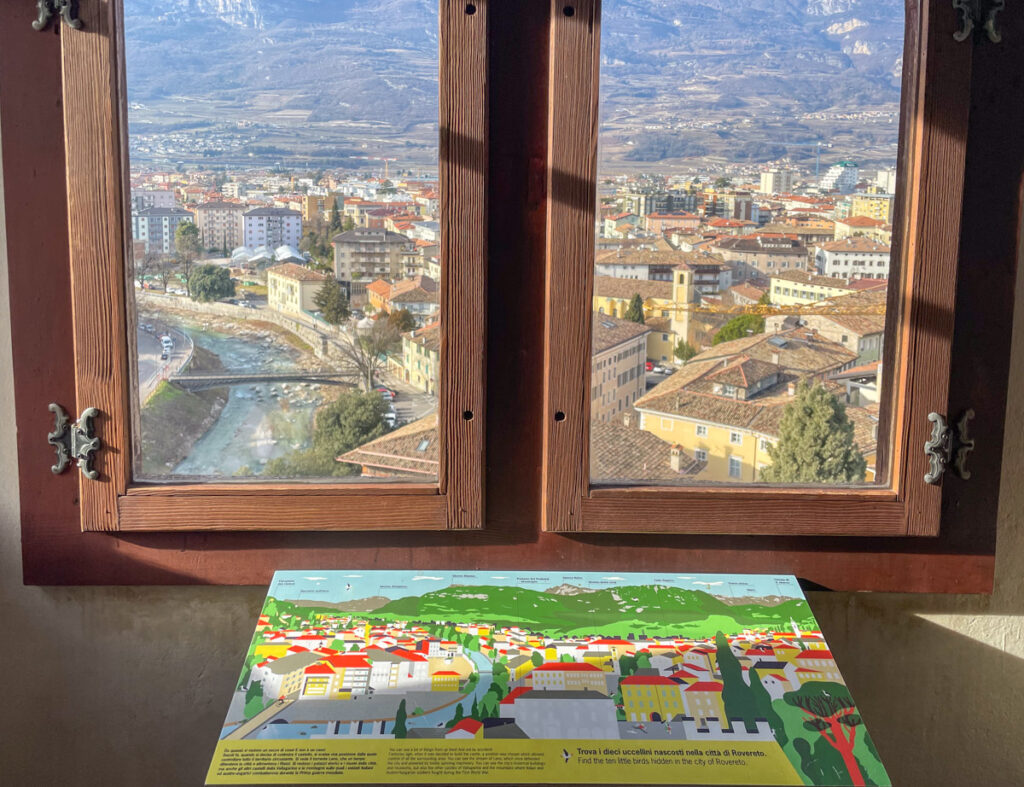
The Museo Storico Italiano della Guerra in Rovereto with children
Despite the complex subject of wars, the Italian War History Museum in Rovereto is quite engaging with children. The exhibition and tour route introduce children to historical topics such as wars and their economic and social consequences.
Almost every room has explanations for children, highlighted in yellow, with some installations designed for them. In particular, in the first part of the tour, children can try to match the fitting uniforms or put together patriotic objects with magnetic puzzles.
My son also really enjoyed the video on how the architecture of Rovereto Castle has changed over the centuries, with the addition of towers and embankments as a defensive element of the artillery. As well, of course, as the Nieuport-Macchi Ni.10 biplane used in the First World War and the explanations on submarines.
Visiting the Italian War History Museum in Rovereto with children can be a very educational experience, making them curious about the history and conflicts of the last century. I therefore recommend that you consider this museum on a family trip, even though it may seem like it could be more suitable at first glance.
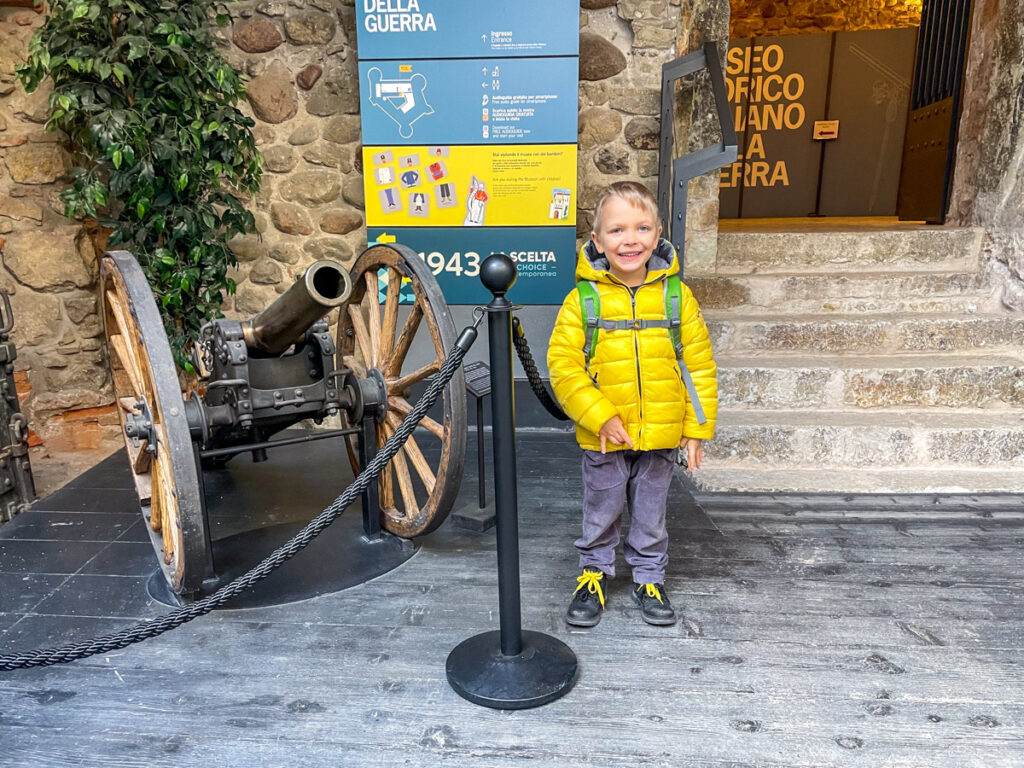
Practical information for visiting the Italian War History Museum in Rovereto
The Italian War History Museum is open from Tuesday to Sunday, from 10:00 to 18:00, with the last admission at 17:00. The museum is closed on non-holiday Mondays and on specific dates such as 24, 25 and 31 December and 1 January. The ‘Artillery of the Great War 1914-18’ section, with entrance from Piazza del Podestà, is only open from May to October. The ticket, purchased directly at the ticket office, costs €11, but admission is free for visitors under 18.
The best way to reach the museum is on foot, despite a short climb from the centre of Rovereto. If you move by car, you risk not finding a parking space. The paid car parks in the vicinity all have a very limited number of spaces. I, for example, had to park in front of the Mart, about 20 minutes’ walk away.
Museo Storico Italiano della Guerra (Italian War History Museum)
Via Guglielmo Castelbarco, 7
38068 Rovereto (TN)
Where to stay in Rovereto
Rovereto is a small city near Trento. Hotel Leon d’Oro is an excellent accommodation with an outdoor pool and free parking, just a 2-minute walk from the train station and near the Mart. Another option is Hotel Rovereto, a boutique hotel in the historic centre of Rovereto with stylish furniture and paintings by famous local artists in the public areas. If you’re on a budget, Ostello Città di Rovereto offers dormitories, private rooms, and vouchers for discounted visits to local museums.
The Museo Storico Italiano della Guerra (Italian War History Museum) in Rovereto is a place that unites past and present with a journey through the history of warfare through the ages and the ever-present reflection on the social and human costs of conflict. Feel free to share your thoughts in the comments, especially if you already know this museum or felt like visiting it by reading this article.
